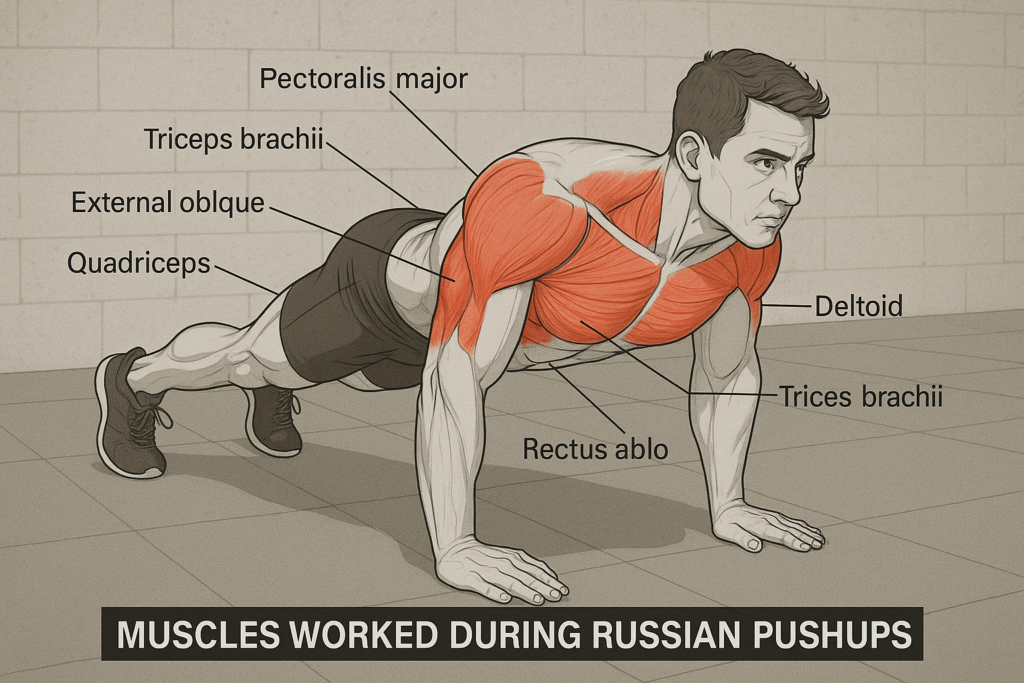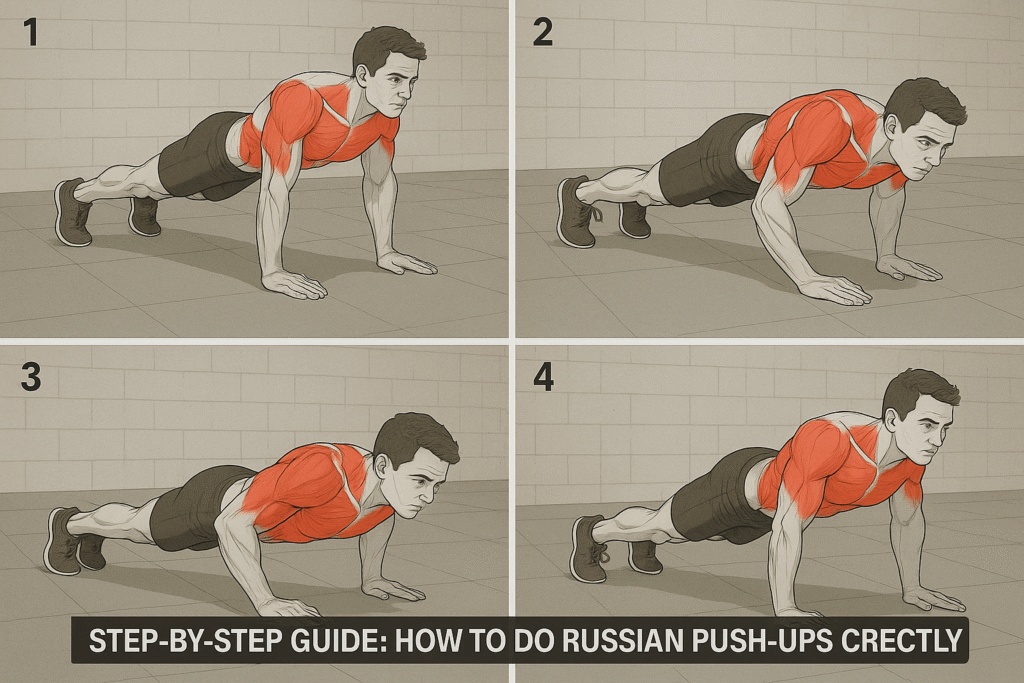Bodyweight exercises have taken the fitness world by storm, and for good reason they’re accessible, effective, and require no fancy equipment. Among these, Russian pushups have emerged as a standout move, blending strength, mobility, and coordination in one dynamic package. If you’re looking to level up your workout routine, this hybrid exercise might just be your new go to. In this article, we’ll dive deep into what Russian pushups are, why they’re so effective, how to perform them with perfect form, and how to seamlessly add them to your fitness plan. Whether you’re a beginner or a seasoned athlete, there’s something here for everyone.
What Are Russian Pushup?

Russian push ups aren’t your average pushups. They’re an advanced variation that combines the classic pushup with a forearm plank transition, creating a fluid, challenging movement. While their exact origins are murky, they’re rooted in calisthenics and functional fitness, often associated with Russian training methods that prioritize strength and mobility. Unlike standard pushups, which focus on a single plane of motion, Russian pushups add a dynamic shift that tests your coordination and core stability.
Why are they so popular? Athletes love them for their ability to build functional strength, while fitness enthusiasts appreciate their no equipment versatility. They’re a hybrid exercise that delivers more bang for your buck than many other bodyweight moves.
Muscles Worked During Russian Pushups
Russian pushups are a full body exercise, engaging multiple muscle groups at once. Let’s break it down:

- Chest (Pectoralis Major): Powers the pushing motion, giving your pecs a solid workout.
- Shoulders (Deltoids): Stabilizes your body and supports the dynamic transition.
- Triceps: Drives the elbow extension, building arm strength.
- Core (Abdominals and Obliques): Keeps your body stable, especially during the forearm shift.
- Upper Back (Rhomboids, Trapezius): Assists in scapular movement and control.
- Hip Stabilizers: Engages to maintain a straight body line.
Russian Pushups for Chest Strength
If you’re chasing a stronger chest, Russian pushups deliver. The pushing phase mimics a traditional pushup, but the added forearm transition increases time under tension, amplifying muscle engagement. Plus, the mobility aspect makes your shoulders more resilient.
Benefits of Russian Pushups
Why should you add Russian pushups to your routine? Here are some compelling reasons:
- Upper Body Strength: They target your chest, shoulders, and triceps with intensity, building power and definition.
- Shoulder Mobility: The forearm transition stretches and strengthens your shoulders, improving range of motion.
- Core Engagement: Your abs and obliques work overtime to keep you stable, enhancing functional strength.
- No Equipment Needed: Perfect for home workouts or travel, Russian pushups require only your body and a bit of space.
- Versatility: They fit into any routine, from calisthenics circuits to strength focused sessions.
I’ve personally found Russian pushups to be a game changer for building strength without a gym. They’re tough but rewarding, and you’ll feel the difference after just a few sessions.
Step-by-Step Guide: How to Do Russian Push Ups Correctly

Ready to try Russian pushups? Here’s a detailed guide to ensure you nail the form:
- Start in a High Plank: Place your hands shoulder width apart, body in a straight line from head to heels. Engage your core to avoid sagging hips.
- Lower to Forearm Plank: Bend one elbow and lower it to the ground, resting on your forearm. Follow with the other arm, keeping your body stable.
- Push Back Up: From the forearm plank, press one hand into the ground to lift back to the high plank. Follow with the other hand.
- Alternate Sides: Switch the leading arm each rep to maintain balance and coordination.
- Repeat Smoothly: Aim for controlled, fluid transitions rather than rushing.
Common Mistakes to Avoid
- Sagging Hips: This strains your lower back. Keep your core tight and glutes engaged.
- Flaring Elbows: Elbows should stay close to your body to protect your shoulders.
- Rushing the Transition: Slow, deliberate movements maximize muscle engagement and reduce injury risk.
- Poor Head Position: Keep your neck neutral, looking slightly ahead.
Pro tip: If you’re struggling, practice the forearm plank transition separately before combining it with the pushup. A quick video or diagram can also clarify the flow check out resources like the American Council on Exercise for visuals.
Russian Pushups vs Traditional Pushups
Not sure how Russian pushups stack up against the classic version? Here’s a side by side comparison:
| Aspect | Russian Pushups | Traditional Pushups |
| Difficulty | Advanced, requires coordination | Beginner-friendly, straightforward |
| Muscle Engagement | Chest, shoulders, triceps, core, back | Chest, shoulders, triceps, some core |
| Mobility | High, improves shoulder flexibility | Low, minimal dynamic movement |
| Best For | Functional training, calisthenics | Building foundational strength |
Russian pushups are tougher but offer more in terms of mobility and core work. Traditional push ups are great for beginners or when you want a simpler move. I like to mix both in my routine traditional for volume, Russian for intensity.
How to Add Russian Pushups to Your Workout Routine
Russian pushups can fit into any workout plan, whether you’re a newbie or a pro. Here’s how to get started based on your level:
- Beginners: Start with 2 sets of 8–10 reps, resting 60 seconds between sets. Focus on form over speed.
- Intermediate: Try 3 sets of 12–15 reps, pairing with bodyweight squats or lunges for a balanced circuit.
- Advanced: Go for 4 sets of 20 reps, slowing the tempo or adding a pause in the forearm plank for extra challenge.
Warm Up and Cool Down
Before diving in, prep your body:
- Warm Up: 5 minutes of dynamic stretches like arm circles, cat cow, and light planks.
- Cool Down: Stretch your shoulders, chest, and wrists with moves like child’s pose or doorway stretches.
Pairing with Other Exercises
Russian pushups shine in a bodyweight circuit. Try this sample workout:
- Russian Pushups: 12 reps
- Bodyweight Squats: 15 reps
- Plank Hold: 30 seconds
- Repeat for 3 rounds
This keeps your heart rate up and hits multiple muscle groups. I’ve used this circuit on busy days when I can’t hit the gym. It’s a lifesaver.
Keywords: Russian pushups workout plan, pushup variations, bodyweight circuit
Russian PushUps Progressions and Modifications
Russian pushups can be scaled to suit any fitness level. Here’s how:
- Easier Version: Perform with knees on the ground to reduce the load. This is great for beginners or those with limited upper body strength.
- Harder Version: Add a 2 second pause in the forearm plank or slow the transition to increase time under tension.
- Calisthenics Progression: Once you’ve mastered Russian pushups, combine them with pull ups, dips, or pistol squats for a full body challenge.
I started with knee supported Russian pushups and gradually worked up to the full version. It took patience, but the progress felt amazing.
Who Should Avoid Russian Pushups?
While Russian pushups are fantastic, they’re not for everyone. Skip them if you have:

- Shoulder or Elbow Injuries: The dynamic movement can aggravate existing issues.
- Wrist Problems: The forearm transition puts pressure on your wrists.
- Limited Mobility: If your shoulders or core feel strained, start with modifications.
If you’re unsure, consult a certified trainer or physical therapist. They can assess your form and suggest alternatives. I once pushed through shoulder discomfort and regretted listening to your body.
Modifications for Limited Mobility
- Use an elevated surface (like a bench) to reduce the range of motion.
- Stick to the forearm plank transition without the push up until you’re ready.
Conclusion
Russian pushups are more than just a fancy pushup variation; they’re a powerful tool for building strength, mobility, and core stability. Whether you’re working out at home, traveling, or diving into calisthenics, this move can elevate your fitness game. Start with the basics, focus on form, and gradually challenge yourself with progressions. The payoff? A stronger, more mobile body that’s ready for anything.
Ready to give Russian pushups a shot? Try the workout plan above and let us know how it goes in the comments. For more bodyweight exercise tips, subscribe to our newsletter or download our free calisthenics guide. Your fitness journey just got a whole lot more exciting!
FAQs About Russian Pushups
Russian pushups combine a regular pushup with a transition into a forearm plank, adding mobility and core control.
Chest, triceps, shoulders, core, and upper back.
Not necessarily “better,” but they offer more mobility and core engagement. Regular pushups are great for building raw strength, while Russian pushups add a functional twist. It depends on your goals.
Absolutely. They promote hypertrophy in your chest, shoulders, and triceps, especially with progressive overload (more reps, slower tempo, or added pauses).
Beginners can start with 8–10 reps per set, aiming for 2–3 sets. As you get stronger, increase to 15–20 reps or add sets. Listen to your body to avoid overdoing it.
They’re advanced, but beginners can try modified versions (like knee-supported) and gradually progress. Patience is key.
